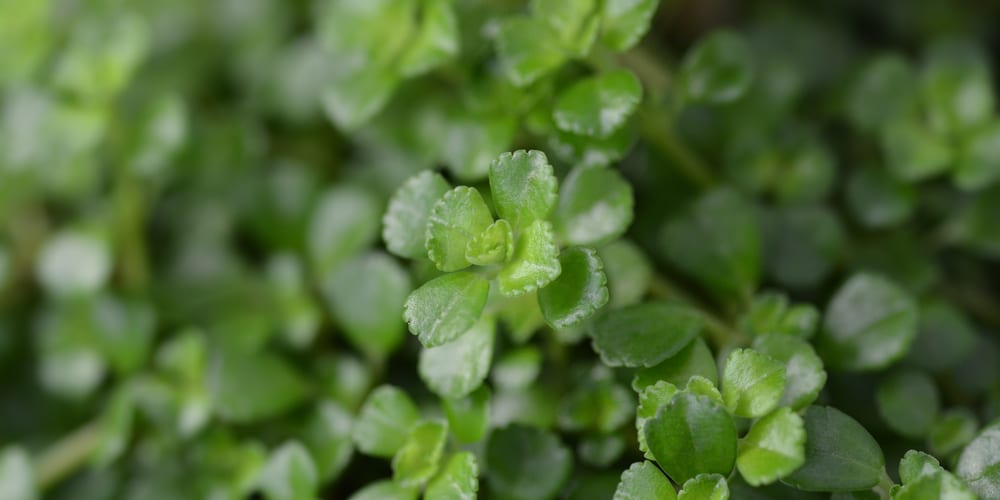Depressed Clearweed is a small vine that features thick and prominent scallop leaves. Also known as Baby’s tears, this evergreen climber can reach up to 40 inches in height and 20 inches in length from side to side. While the most attractive feature is the small and thick leaves, the plant also gives beautiful white and pink flowers during the spring.
It is a versatile plant, particularly well suited to indoor conditions. Native to the forest of Mexico and Brazile, Depressed Clearweed is a popular hanging pot plant that will help brighten your house by adding an aesthetic touch.
To learn more about how to care for this plant and what to do to ensure you provide it with the right conditions, keep reading our essential guide.
Depressed Clearweed Growth and Care
One of the best things about this climbing plant is the ease of care. Because it is a tropical plant, it prefers warm and humid environments without direct exposure to the sun. If you wish to grow it indoors, you can unleash your creativity. Depressed Clearweed does well in containers on the ground or tabletops. However, it creates a beautiful impression on high shelves and hanging baskets.
Depressed Clearweed Growth and Care: Sunlight
Like other tropical plants, Depressed Clearweed does much better without constant sunlight. To maximize its growth potential, place it no more than three feet from a window that gets morning light. As a rule of thumb, it shouldn’t get more than 4 hours of sunlight to avoid its leave turning brown. If your house gets much sunlight all day long, don’t worry. Consider getting sheer curtains or drapes. Also, if you don’t find a suitable spot for natural lighting, you can think about getting artificial lights.
Watering
Depressed Clearweed should look moist but not wet. Avoid letting the soil fully dry out. In general, you should give your plant a cup of water every nine days if it doesn’t get direct sunlight. Of course, the amount of water also depends on the size of your plant. Bigger ones are more thirsty!
Overwatering can be a problem: give your plant little water frequently instead of much water once in a while.
Pruning
Clearweed is a small plant that doesn’t require much pruning. However, because it grows in all directions, you may want to give it some shape. You can trim the plan as you wish, but remember to use sharp and clean scissors to avoid causing damage to the plant.
Humidity
This plant needs high temperatures and medium to high humidity to survive. After all, its natural habitat is the tropical forest! To ensure it remains moist, you can mist it with water using a spray bottle onto the leaves. Remember to avoid leaving water stagnant. Instead, make sure it gets proper aeration to dry the leaves after a couple of hours from misting.
USDA Climate Zones for Outdoor Growing
This tropical plant thrives indoors, but can grow outside, provided it receives the required amount of humidity and heat. According to the USDA, the best areas for growing Depressed Clearweed outside are zones 10, 11, and 12. Warmer southern states and regions with mild climates can offer the appropriate conditions.
Fertilizer
You can use a general liquid fertilizer for houseplants during spring and summer to accelerate growth. Choose one that contains nitrogen, potassium, and phosphorous. Of course, it is not necessary, but it can be beneficial for the well-being of your plant. Remember to water your plant before proceeding with fertilization.
Depressed Clearweed Growth and Care: Soil Type
This plant does well in any indoor potting mix with some perlite. The soil should have the ability to hold water and satisfy the plant’s moist requirements. In general, it is best to choose smaller pots to allow the plant’s roots to be restricted. If you prefer to mount it on a board, you’ll have to use a substrate that drains quickly without retaining too much moisture.
Propagation
Water propagation is an effective technique to grow this plant. Make a few cuttings between the nodes (where the leaves attach to the stem) and place them in a jar of water.
Make sure the jar gets enough natural indirect sunlight to ensure healthy growth. When you notice some roots developing, it is time to move the cuttings in a small pot with moist potting mix. You can achieve similar results by planting your fresh cuttings directly into the soil.
Depressed Clearweed Growth and Care: Conclusion
This plant is not hard to grow but requires constant watering and a specific environment. If you can provide that, you’ll be able to recreate a little forest at home!

